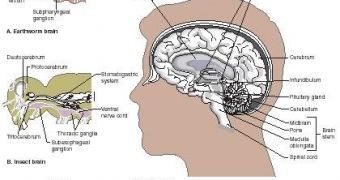Abject worm... But in fact we are nothing more than backboned worms. Now, a team at the European Molecular Biology Laboratory [EMBL] in Heidelberg have even managed to show how our brains originated in the primitive central nervous systems of worms.
Vertebrates are known for long to have evolved from an ancient common ancestor with the insects and worms, even if they do not look much alike today.
It's the spinal cord (backbone) that induced vertebrates a specific evolutionary way, while insects and annelid worms (earthworms are the most known) have simple central nervous system with a fore cluster of nerve cells that barely can be named a brain, and many clusters of nerves bound in a chain along their bellies.
That's why biologists presumed that these central nervous systems, so different in vertebrates and insect-worm group, appeared independently, only after the split. (in other words, the primitive common ancestor had not yet a central nervous system).
The team investigated the embryos of a marine annelid worm called Platynereis dumerilii, which displays a very basic structure of the nervous system, unchanged for eons, tracking down the molecular fingerprints of the developing neurons.
"Our findings were overwhelming. The molecular anatomy of the developing CNS [central nervous system] turned out to be virtually the same in vertebrates and Platynereis. Corresponding regions give rise to neuron types with similar molecular fingerprints and these neurons also go on to form the same neural structures in annelid worm and vertebrates." said study co-author Alexandru Denes.
"Such a complex arrangement could not have been invented twice throughout evolution, it must be the same system," said co-researcher G?sp?r J?kely.
"It looks like Platynereis and vertebrates have inherited the organization of their CNS from their remote common ancestors."
The greatest puzzle that researchers must solve is: How did the central nervous systems move from belly to backside?
"How the inversion occurred and how other invertebrates have modified the ancestral CNS throughout evolution are the next exciting questions for evolutionary biologists," said lead researcher Detlev Arendt.

 14 DAY TRIAL //
14 DAY TRIAL //